World Heritage in Japan 12
Sacred Sites and Pilgrimage Routes
in the Kii Mountain Range
Sacred Sites and Pilgrimage Routes in the Kii Mountain Range
(Culture, registered in 2004)
The Kii Mountain Range covers most of the Kii Peninsula that juts out into the Pacific Ocean. A mountain range of 1,000-2,000m runs from East to West and from North to South and over 3,000mm of annual rainfall supports deep forests
Kii Mountain Range has been believed as special area where Gods stay from
the mythological times Buddhism which came from China also regardes this
thickly forested mountain range as 'Jodo (heaven)', so Buddhist monks have
performed ascetic training here to obtain the special power which Buddha
has. Thus, three sacred sites and pilgrimage routes were formed and became
very influential place for the development of Buddhism in Japan having
many visitors from all over the country.
The main features of the Sacred Sites and Pilgrimage Routes in the Kii
Mountain Range which lie over three prefectures (MIe, Nara and Wakayama)
are the sacred sites and pilgrimage routes, and the cultural landscapes
around them that could not have been formed without the nature of the Kii
Mountains. Unique in Japan and rare even in the world, they are very valuable
properties
Yoshino-Omine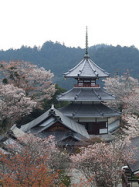
The sacred site for Shugendo Yoshino and Omine, which consists of steep mountains reaching altitudes of over 1,000m, is divided into two parts. North of Mt. Aonegamine of the Omine Mountains, which is the water divide of the Kii Mountains, is called "Yoshino" and south of it is called "Omine". Already in the mid-10th century, the status of this region as the most important sacred mountain in Japan had been established to such extent that its reputation reached China.
Yoshino that had been the object of the mountain worship from ancient times
became increasingly active and influential, received attention largely
in association with En no Gyoja. Shugendo, which put importance on mountain
ascetic practices, calls walking through the mountains with hard practice
'Okugake' or 'Mineiri', and Omine is the stage for it and became the model
of mountain worship sites.
Yoshino is also famous for cherry blossom which was planted because they regards the cherry tree as sacred tree. So, Yoshino gives unprecedented cultural landscape in Japan.
Kumano Sanzan (Kumano Three Shrines)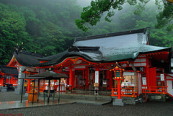
Located at the southeastern part of the Kii Mountain Range, Kumano Sanzan
includes the three shrines of 'Kumano Hongu Taisha', 'Kumano Hayatama Taisha'
and 'Kumano Nachi Taisha', and two temples of 'Seiganto-ji' and 'Fudarakusan-ji'
that are distributed 20 to 40 km apart from each other and connected by
'Kumano Sankeimichi Nakahechi'.
Although these three shrines have original distinctive forms, they have
exchanged their gods with each other and have been worshiped as 'Kumano
Sansho Gongen'. They came to be revered as the destination of the Kumano
Pilgrims by 'the Shinto-Buddhism Unity Theory' that teaches God is the
manifestation of Buddha and the fact that their main gods were considered
as the incarnation of 'Amida-nyorai', 'Yakushi-nyorai' and 'Senju-kannon'
The pavilions of Kumano Three Shirines have very unique form and became
the standard for 3,000 affiliated shirines all over the country.
Koyasan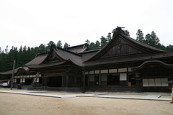
Koyasan includes 'Kongobu-ji' that was built by Kukai in 816 as the principal stage for esoteric Buddhism on a 800m high mountain basin, 'Jison-in' that was built as an administrative office to facilitate the construction and management of Kongobu-ji, 'Niukanshofu-jinja' that was constructed as a guardian shrine to protect the Niukanshofu estate of Kongobu-ji and 'Niutsuhime-jinja' that is situated in the Amano basin between Kongobu-ji and Jison-in which is closely connected to Koyasan and enshrines 'Koya Myojin,' who legend tells gave land to Kukai when he choose the compound of Kongobu-ji, and 'Niu Myojin', who legend tells guided him, and all of them are connected by the pilgrimage route 'Koyasan Choishimichi'.
Having 1200 years of religious history, Koyasan is a mountain top religious
city formed by 117 temples, combined with the surrounding steep mountain
ridges and deep forests, it produces a cultural landscape related to faith.
Especially Okunoin where Kukai (Kobo-daishi) became living Buddha in Heian
era and believed still alive, people still continue to build tomb stone
together with the belief in Kukai.
Pilgrimage Routes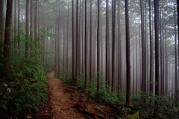
There are folliwing Pilgrimage Routes which connect three Sacred Sites.
- Omine Okukake Michi
- Kumano Sankeimichi
�@(Kohechi, Nakahechi, Ohetchi, Iseji)
- Koyasan Chosekimichi
The total length is 307.6�q.
It is the second world heritage as 'route' following to the Pilgrimage
Routes of Santiago de Compostera in Spain and France.
Three Sacred Sites of Kii Mountain Range were different each other at the begining, but by the connection with these routes, Buddhism integrated with Shinto.
(Reference: Website of Wakayama Prefecture the World Heritage Registration
Association, and Wakayama Tourism Federation)
How to access to Yoshinoyama (example)
Tokyo Station-(Shinkansen)-Kyoto Station-(Kintetesu Line)-
Yoshino Station-(ropeway)-Yoshinoyama
Total time: about 5 hours
How to access to Kumano Hongu Taisha (example)
Tokyo Station-(Shinkansen)-Nagoya Station-(JR)-Shingu Station-
(bus)-Hongu Taisha Mae
Total time: about 6.5 hours
How to access to Koyasan (example)
Tokyo Station-(Shinkansen)-Shinosaka Station-(JR)-
Shin Imamiya Station-(Nankai Line)-Gokurakubashi Station-
(cable car)-Koyasan
Total time: about 5.5 hours
* Area is very large over 3 prefectures, so the accesses are different
by the destinations.
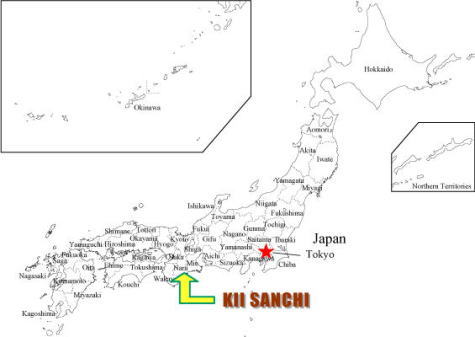
|
|
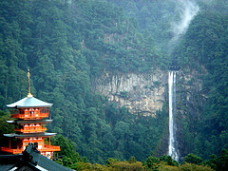
Three-Storied Pagoda of Seigantoji Temple and Nachi Waterfall
 Top page Top page
 General information of Japan General information of Japan
 World heritage in Japan World heritage in Japan
�@�@�@-Horyuji Temple
�@�@�@-Himeji Castle
�@�@�@-Yaku Island
�@�@�@-Shirakami Mountain Range
�@�@�@-Ancient Kyoto
�@�@�@-Shirakawa-go and Gokayama
�@�@�@-Hiroshima Peace Memorial
�@�@�@-Itsukushima Shrine
�@�@�@-Ancient Nara
�@�@�@-Shrines and Temples in Nikko
�@�@�@-Kingdom of Ryukyu�@
�@�@�@-Kii Mountain Range�@
�@�@�@-Shiretoko
�@�@�@-Iwami Silver Mine
�@�@�@-Ogasawara Islands
�@�@�@-Hiraizumi
�@�@�@-Mount Fuji
�@�@�@-Tomioka
�@�@�@-Site of Industrial Revolution
�@�@�@-Architectural Work of Le Corbusier
�@�@�@-Okinoshima & Munakata
 Accommodation in Japan Accommodation in Japan
 Japanese food Japanese food
�@�@
 Japanese culture (National Treasures) Japanese culture (National Treasures)
 Japanese culture 2 (Culture in everyday life) Japanese culture 2 (Culture in everyday life)
 Japanese sports Japanese sports
 Japanese religion Japanese religion
 Souvenir of Japan Souvenir of Japan
 continually updated ! continually updated !
 Travel Diary in Tokyo Travel Diary in Tokyo
 My profile My profile
 Link Link
 English Guiding Service English Guiding Service
 info@ltij.net
info@ltij.net
|


